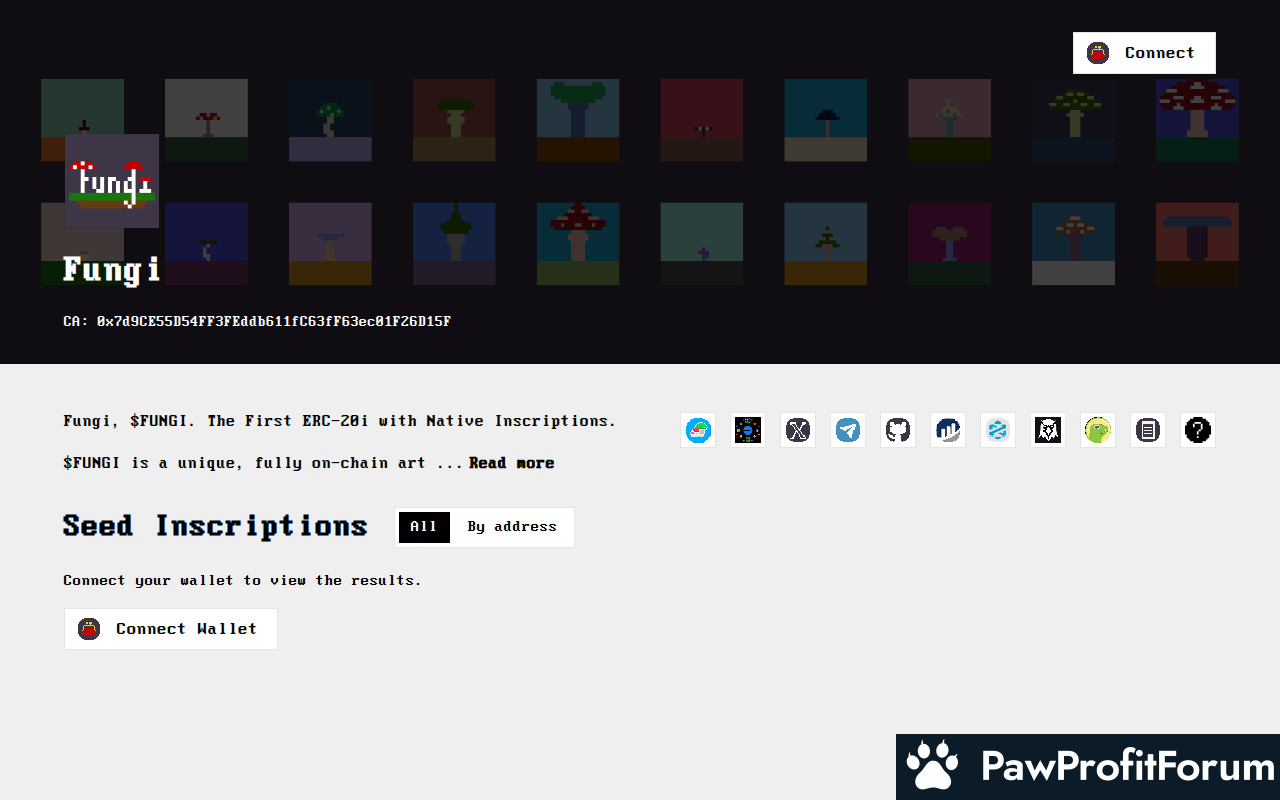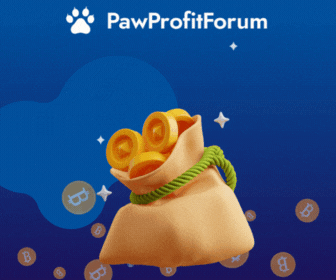$FUNGI is a unique, fully on-chain art project offering an innovative new ERC-20i format with inscription metadata. Each portion of tokens resembles a seed that generates unique 24x24 dynamic images of Fungi stored on-chain, depending on the wallet's token balance.
To achieve a visual rendering of the project, we built a front end and uploaded it to the decentralized IPFS storage, making the project immutable. All project files, including the arts, smart contracts, and the frontend app's source codes, were uploaded to the project's GitHub page for other developers who want to utilize the new ERC-20i inscriptions format.
The project leverages the decentralized IPFS storage to ensure immutability, meaning that all project files, including art, smart contracts, and the frontend app's source codes, are permanently stored and accessible. This decentralized approach not only enhances security but also ensures that the visual rendering of the project remains unaltered over time.
Developers and enthusiasts can explore Fungi's intricacies through its GitHub repository, which hosts all relevant files and documentation. This open-source nature encourages collaboration and further innovation within the blockchain community. Additionally, Fungi maintains an active presence on social media platforms like Twitter, where updates and community interactions are frequent.
The dynamic images generated by Fungi tokens are not just static representations; they evolve based on the balance in the holder's wallet, making each token a living piece of digital art. This integration of art and technology exemplifies the potential of blockchain to create new forms of interactive and immutable digital assets.
The ERC-20i format is particularly notable for its inscription metadata, which means that all the data related to the art is stored directly on the blockchain. This ensures that the art is immutable and cannot be altered or tampered with. The use of inscription metadata allows for a seamless integration of visual elements with the token's data, making each token a piece of dynamic, living art.
Security is a paramount concern in any blockchain project, and Fungi addresses this through the inherent properties of the Ethereum blockchain. Ethereum uses a decentralized network of nodes to validate transactions and maintain the integrity of the blockchain. This decentralized nature makes it extremely difficult for bad actors to manipulate the system. Each transaction is verified by multiple nodes, and any attempt to alter the blockchain would require a consensus from the majority of the network, which is practically impossible to achieve for malicious purposes.
Moreover, the smart contracts governing Fungi are open-source and have been uploaded to the project's GitHub page. This transparency allows other developers to scrutinize the code, ensuring that there are no hidden vulnerabilities. The smart contracts are responsible for managing the creation, transfer, and destruction of tokens, as well as the generation of the dynamic images. By being open-source, these contracts invite community participation and trust, further enhancing the security and reliability of the project.
To provide a visual rendering of the project, a front-end application was developed and uploaded to the InterPlanetary File System (IPFS). IPFS is a decentralized storage solution that ensures the project's files, including the art, smart contracts, and source codes, are immutable and always accessible. This decentralized storage method complements the blockchain's security features, ensuring that the visual and functional aspects of Fungi remain intact and unaltered.
The dynamic images generated by Fungi tokens are not just static pictures but are designed to evolve based on the token balance in the wallet. This means that as the number of tokens in a wallet changes, the corresponding image also changes, creating a living piece of art that reflects the state of the wallet. This innovative approach combines the principles of digital scarcity and dynamic art, offering a unique experience to the token holders.
In addition to the technological aspects, Fungi also emphasizes community involvement. By making all project files and smart contracts available on GitHub, the project encourages developers to experiment with and build upon the ERC-20i format. This open-source approach fosters innovation and collaboration within the blockchain and digital art communities, potentially leading to new applications and enhancements of the technology.
The combination of the ERC-20i standard, inscription metadata, decentralized storage via IPFS, and the dynamic nature of the generated art makes Fungi a unique project in the cryptocurrency space. Each element of the technology behind Fungi is designed to ensure security, immutability, and a seamless integration of art and blockchain, offering a novel experience to its users and developers alike.
One of the real-world applications of Fungi includes trading on BasedSwap, a decentralized exchange where users can buy, sell, or trade FUNGI tokens. This platform allows users to engage in decentralized finance (DeFi) activities, leveraging the unique properties of the FUNGI token.
Additionally, owning FUNGI tokens allows individuals to own a piece of digital history. Each token acts as a seed that generates a unique piece of art, making it a collectible item. This aspect of Fungi appeals to art enthusiasts and collectors who value the intersection of art and technology.
Fungi also fosters a sense of community among its users. Through social media platforms like Twitter, users can connect, share their unique fungi images, and discuss the latest developments in the project. This social aspect enhances user engagement and creates a vibrant community around the cryptocurrency.
The project’s commitment to decentralization is evident in its use of IPFS (InterPlanetary File System) for storage. By uploading all project files, including art, smart contracts, and source codes, to IPFS, Fungi ensures that the project remains immutable and accessible to developers and users alike.
In the art world, Fungi has potential applications due to its unique approach to digital art. The dynamic images generated by the tokens can be displayed, traded, and appreciated as digital art pieces, adding a new dimension to the concept of art ownership and appreciation in the digital age.
The launch of the Fungi Token marked a significant milestone. This event introduced the ERC-20i format, which allows for the inscription of metadata directly onto the blockchain. This format ensures that each token can generate a unique visual representation, making it a novel addition to the cryptocurrency and blockchain art space.
Following the token launch, the development team focused on creating a front-end interface for the project. This interface was uploaded to the decentralized IPFS storage, ensuring the project's immutability. By storing all project files, including the art, smart contracts, and the frontend app's source codes, on the project's GitHub page, the team provided transparency and accessibility for other developers interested in utilizing the ERC-20i inscriptions format.
Upcoming NFT drops have been announced, adding another layer of engagement for the community. These drops are expected to further integrate the unique visual elements of the Fungi tokens, offering collectors and enthusiasts new ways to interact with and appreciate the project's art.
At the time of writing, there have been no additional key events for Fungi.
To achieve a visual rendering of the project, we built a front end and uploaded it to the decentralized IPFS storage, making the project immutable. All project files, including the arts, smart contracts, and the frontend app's source codes, were uploaded to the project's GitHub page for other developers who want to utilize the new ERC-20i inscriptions format.
What is Fungi?
Fungi (FUNGI) stands out as an innovative cryptocurrency that merges blockchain technology with digital art. As an ERC-20i token, Fungi introduces a novel approach by embedding inscription metadata directly on-chain. This unique feature allows each token to act like a seed, generating dynamic 24x24 pixel images of fungi based on the token holder's balance.The project leverages the decentralized IPFS storage to ensure immutability, meaning that all project files, including art, smart contracts, and the frontend app's source codes, are permanently stored and accessible. This decentralized approach not only enhances security but also ensures that the visual rendering of the project remains unaltered over time.
Developers and enthusiasts can explore Fungi's intricacies through its GitHub repository, which hosts all relevant files and documentation. This open-source nature encourages collaboration and further innovation within the blockchain community. Additionally, Fungi maintains an active presence on social media platforms like Twitter, where updates and community interactions are frequent.
The dynamic images generated by Fungi tokens are not just static representations; they evolve based on the balance in the holder's wallet, making each token a living piece of digital art. This integration of art and technology exemplifies the potential of blockchain to create new forms of interactive and immutable digital assets.
What is the technology behind Fungi?
The technology behind Fungi (FUNGI) is a fascinating blend of blockchain innovation and digital art. At its core, Fungi operates on the Ethereum blockchain, utilizing the ERC-20i standard. This standard is an extension of the widely known ERC-20 token standard, but with a twist that integrates fully on-chain art. Each token in the Fungi ecosystem is not just a digital asset but also a seed that generates unique 24x24 dynamic images of fungi, depending on the wallet's token balance.The ERC-20i format is particularly notable for its inscription metadata, which means that all the data related to the art is stored directly on the blockchain. This ensures that the art is immutable and cannot be altered or tampered with. The use of inscription metadata allows for a seamless integration of visual elements with the token's data, making each token a piece of dynamic, living art.
Security is a paramount concern in any blockchain project, and Fungi addresses this through the inherent properties of the Ethereum blockchain. Ethereum uses a decentralized network of nodes to validate transactions and maintain the integrity of the blockchain. This decentralized nature makes it extremely difficult for bad actors to manipulate the system. Each transaction is verified by multiple nodes, and any attempt to alter the blockchain would require a consensus from the majority of the network, which is practically impossible to achieve for malicious purposes.
Moreover, the smart contracts governing Fungi are open-source and have been uploaded to the project's GitHub page. This transparency allows other developers to scrutinize the code, ensuring that there are no hidden vulnerabilities. The smart contracts are responsible for managing the creation, transfer, and destruction of tokens, as well as the generation of the dynamic images. By being open-source, these contracts invite community participation and trust, further enhancing the security and reliability of the project.
To provide a visual rendering of the project, a front-end application was developed and uploaded to the InterPlanetary File System (IPFS). IPFS is a decentralized storage solution that ensures the project's files, including the art, smart contracts, and source codes, are immutable and always accessible. This decentralized storage method complements the blockchain's security features, ensuring that the visual and functional aspects of Fungi remain intact and unaltered.
The dynamic images generated by Fungi tokens are not just static pictures but are designed to evolve based on the token balance in the wallet. This means that as the number of tokens in a wallet changes, the corresponding image also changes, creating a living piece of art that reflects the state of the wallet. This innovative approach combines the principles of digital scarcity and dynamic art, offering a unique experience to the token holders.
In addition to the technological aspects, Fungi also emphasizes community involvement. By making all project files and smart contracts available on GitHub, the project encourages developers to experiment with and build upon the ERC-20i format. This open-source approach fosters innovation and collaboration within the blockchain and digital art communities, potentially leading to new applications and enhancements of the technology.
The combination of the ERC-20i standard, inscription metadata, decentralized storage via IPFS, and the dynamic nature of the generated art makes Fungi a unique project in the cryptocurrency space. Each element of the technology behind Fungi is designed to ensure security, immutability, and a seamless integration of art and blockchain, offering a novel experience to its users and developers alike.
What are the real-world applications of Fungi?
Fungi (FUNGI) is a distinctive cryptocurrency that intertwines the digital art world with blockchain technology. Unlike many other cryptocurrencies, Fungi offers a unique, fully on-chain art project that utilizes an innovative ERC-20i format with inscription metadata. This means that each token not only represents a piece of digital currency but also generates unique 24x24 dynamic images of fungi, stored directly on the blockchain.One of the real-world applications of Fungi includes trading on BasedSwap, a decentralized exchange where users can buy, sell, or trade FUNGI tokens. This platform allows users to engage in decentralized finance (DeFi) activities, leveraging the unique properties of the FUNGI token.
Additionally, owning FUNGI tokens allows individuals to own a piece of digital history. Each token acts as a seed that generates a unique piece of art, making it a collectible item. This aspect of Fungi appeals to art enthusiasts and collectors who value the intersection of art and technology.
Fungi also fosters a sense of community among its users. Through social media platforms like Twitter, users can connect, share their unique fungi images, and discuss the latest developments in the project. This social aspect enhances user engagement and creates a vibrant community around the cryptocurrency.
The project’s commitment to decentralization is evident in its use of IPFS (InterPlanetary File System) for storage. By uploading all project files, including art, smart contracts, and source codes, to IPFS, Fungi ensures that the project remains immutable and accessible to developers and users alike.
In the art world, Fungi has potential applications due to its unique approach to digital art. The dynamic images generated by the tokens can be displayed, traded, and appreciated as digital art pieces, adding a new dimension to the concept of art ownership and appreciation in the digital age.
What key events have there been for Fungi?
Fungi (FUNGI) stands out as a unique, fully on-chain art project that leverages the innovative ERC-20i format with inscription metadata. Each token functions as a seed, generating unique 24x24 dynamic images of fungi, stored on-chain and influenced by the wallet's token balance.The launch of the Fungi Token marked a significant milestone. This event introduced the ERC-20i format, which allows for the inscription of metadata directly onto the blockchain. This format ensures that each token can generate a unique visual representation, making it a novel addition to the cryptocurrency and blockchain art space.
Following the token launch, the development team focused on creating a front-end interface for the project. This interface was uploaded to the decentralized IPFS storage, ensuring the project's immutability. By storing all project files, including the art, smart contracts, and the frontend app's source codes, on the project's GitHub page, the team provided transparency and accessibility for other developers interested in utilizing the ERC-20i inscriptions format.
Upcoming NFT drops have been announced, adding another layer of engagement for the community. These drops are expected to further integrate the unique visual elements of the Fungi tokens, offering collectors and enthusiasts new ways to interact with and appreciate the project's art.
At the time of writing, there have been no additional key events for Fungi.
Who are the founders of Fungi?
Fungi (FUNGI) stands out as a unique, fully on-chain art project leveraging the innovative ERC-20i format with inscription metadata. The masterminds behind Fungi are Alejandro Dopico and Rodrigo Yassin. They have made significant strides in the cryptocurrency industry, particularly with Fungi, a DeFi AI Agent that facilitates on-chain transactions and provides expert-level crypto insights. Additionally, they are involved in an on-chain art project introducing the ERC-20i token standard, which allows for unique and dynamic token inscriptions akin to Bitcoin. Their work includes developing a front end for visual rendering, stored on decentralized IPFS storage, ensuring the project's immutability.| Website | fungifungi.art/ |
| Website | fungifungi.art/whitepaper.pdf |
| Socials | twitter.com/Fungi_ERC20i |
| Socials | github.com/ToddStool/fungi |
| Socials | t.me/fungi_erc20i |
| Contracts | 0x7d9c...26d15f |
| Explorers | basescan.org/token/0x7d9ce55d54ff3feddb611fc63ff63ec01f26d15f |










